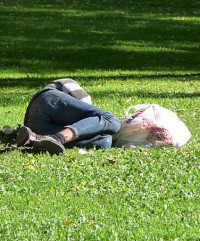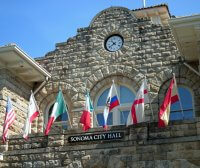 Our fixed-city way-of-life has created a problematic situation: homelessness. Those who cannot afford to own or rent a home are left to wander the highways, alleys and shelters of our urban environments in search of safe spots in which to rest and sleep. The reasons for their poverty vary: personal failure, substance abuse, mental illness, job loss, bad luck and so forth. For those of us not living on the street it’s important to remember how easily any of us could fall prey to the predation of modern society and its increasing absence of “safety net” services.
Our fixed-city way-of-life has created a problematic situation: homelessness. Those who cannot afford to own or rent a home are left to wander the highways, alleys and shelters of our urban environments in search of safe spots in which to rest and sleep. The reasons for their poverty vary: personal failure, substance abuse, mental illness, job loss, bad luck and so forth. For those of us not living on the street it’s important to remember how easily any of us could fall prey to the predation of modern society and its increasing absence of “safety net” services.
Ancient nomadic people were never homeless; they carried what they needed from place to place, moving with the seasons and the food sources which changed with them. Living in tents or other forms of shelter, nomads left no plastic garbage or broken cellphones behind since their lives were, in today’s parlance, “all natural.” A life in nature sustained human culture for many 100,000 years while our rooted existence in fixed, built communities is, according to most archeological records, less than 10,000.
The industrial revolution in England provided a first glimpse of how our modern culture would divide people from land and each other. Enclosure laws walled off land previously lacking borders, evicted peasants from their rural homes and forced the landless into cities. Thrust into lives of menial or industrial labor and living in squalid urban conditions eloquently described by writer Charles Dickens, homelessness became part of the social landscape.
The homeless we see in 21st century America reflects values and beliefs formed during that 19th-century period of industrialization, namely the commodification of land, people and money. Commodification is essentially the process of entangling tangible, produced “things” within a system of monetary value; thus commodities such as wheat, pork bellies and corn are traded within a system of market prices based on estimates of future value. Land, people and money on the other hand are not produced things; land precedes humanity, people are not objects, and money is social invention using symbolic tokens.
In “The Great Transformation” Historian Karl Polonyi documented the creation of our modern economy, the rise of capitalism and its relationship to the commodification of land, people and money. Though fictitious, this commodification underpins the workings of capitalism and is simultaneously responsible for the landless, homeless population we see around us. Though during the past century government has attempted to buffer the worst effects of these fictional commodifications, such efforts have largely failed, and in certain political quarters the supposed motivational value of hunger remains as popular today as it was during the Industrial Revolution.
There are no American forests available to absorb populations disenchanted with urban poverty; moreover, scratching out a life in the wilderness is beyond most people’s capabilities. The off-shoring of jobs, destruction of labor unions, and technological change all but guarantee higher levels of poverty. The nexus of powerful forces – an unforgiving capitalism which seeks the lowest possible cost for commodified labor, the unavailability of free land, and the floating value of currency based on its speculated rather than production value – means homelessness is not going to disappear any time soon. To the contrary, all signs point to increasingly unsustainable socio-economic conditions which in earlier ages led society to collapse.
Here’s a tip: don’t throw out your old Coleman camping stove just yet.







Very powerful and concise analysis of the problem. You are extremely wise and need to run for President. You have told it like it is! Thank You My Brother!